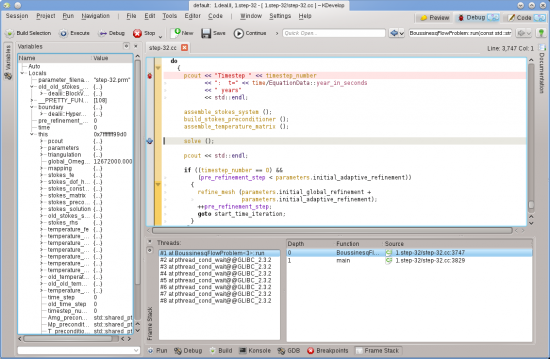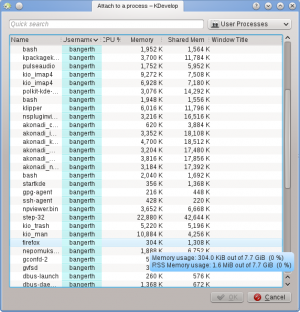KDevelop5/Manual/Debugging programs/da: Difference between revisions
Importing a new version from external source |
Importing a new version from external source |
||
| Line 11: | Line 11: | ||
Når du kører er program i fejlsøgeren, så kommer '''KDevelop''' i en anden tilstand: den vil erstatte værktøjsknapperne i hovedvinduets kant med nogle, som har med fejlsøgning snarere end redigering at gøre. Du kan se, hvilken tilstand du er i øverst til højre i vinduet: der er fanebladene <menuchoice>Eftersyn</menuchoice>, <menuchoice>Fejlsøgning</menuchoice> og <menuchoice>Kode</menuchoice>; ved at klikke på dem kan du skifte imellem de tre forskellige tilstande; hver tilstand har sit eget sæt værktøjer, som kan konfigureres på samme måde, som du gjorde med værktøjerne i <menuchoice>Kode</menuchoice> i afsnittet om [[KDevelop5/Manual/Working_with_source_code#Tools and views|Værktøjer og visninger]]. | Når du kører er program i fejlsøgeren, så kommer '''KDevelop''' i en anden tilstand: den vil erstatte værktøjsknapperne i hovedvinduets kant med nogle, som har med fejlsøgning snarere end redigering at gøre. Du kan se, hvilken tilstand du er i øverst til højre i vinduet: der er fanebladene <menuchoice>Eftersyn</menuchoice>, <menuchoice>Fejlsøgning</menuchoice> og <menuchoice>Kode</menuchoice>; ved at klikke på dem kan du skifte imellem de tre forskellige tilstande; hver tilstand har sit eget sæt værktøjer, som kan konfigureres på samme måde, som du gjorde med værktøjerne i <menuchoice>Kode</menuchoice> i afsnittet om [[KDevelop5/Manual/Working_with_source_code#Tools and views|Værktøjer og visninger]]. | ||
Nå fejlsøgeren standser (ved et stoppunkt eller et sted, hvor <code>abort()</code> kaldes) kan du få forskellig slags information om dit program. I billedet ovenfor har vi for eksempel valgt værktøjet <menuchoice>Frame Stack</menuchoice> for neden i vinduet (det svarer nogenlunde til '''gdb's''' kommandoer "backtrace" og "info threads"), som til venstre viser de forskellige tråde, som i øjeblikket kører i dit program (der er i alt 8) og til højre, hvordan udførslen kom til det aktuelle stoppunkt (her blev <code>run()</code> kaldt fra <code>main()</code>; listen ville være længere, hvis vi var stoppet i en funktion kaldt fra <code>run()</code> selv). Til venstre kan vi inspicere lokale variable, herunder det aktuelle objekt (det objekt, som variablen <code>this</code> henviser til). | |||
From here, there are various possibilities you can do: You can execute the current line (<keycap>F10</keycap>, '''gdb's''' "next" command), step into the functions (<keycap>F11</keycap>, '''gdb's''' "step" command), or run to the end of the function (<keycap>F12</keycap>, '''gdb's''' "finish" command). At every stage, '''KDevelop''' updates the variables shown at the left to their current values. You can also hover the mouse over a symbol in your code, e.g. a variable; '''KDevelop''' will then show the current value of that symbol and offer to stop the program during execution the next time this variable's value changes. If you know '''gdb''', you can also click on the <menuchoice>GDB</menuchoice> tool button at the bottom and have the possibility to enter '''gdb''' commands, for example in order to change the value of a variable (for which there doesn't currently seem to be another way). | From here, there are various possibilities you can do: You can execute the current line (<keycap>F10</keycap>, '''gdb's''' "next" command), step into the functions (<keycap>F11</keycap>, '''gdb's''' "step" command), or run to the end of the function (<keycap>F12</keycap>, '''gdb's''' "finish" command). At every stage, '''KDevelop''' updates the variables shown at the left to their current values. You can also hover the mouse over a symbol in your code, e.g. a variable; '''KDevelop''' will then show the current value of that symbol and offer to stop the program during execution the next time this variable's value changes. If you know '''gdb''', you can also click on the <menuchoice>GDB</menuchoice> tool button at the bottom and have the possibility to enter '''gdb''' commands, for example in order to change the value of a variable (for which there doesn't currently seem to be another way). | ||
Revision as of 08:18, 1 October 2017
Fejlsøgning af programmer i KDevelop
Kør et program i fejlsøgeren
Når du har konfigureret en opstarter (se Kør programmer), så kan du også køre det i fejlsøgeren: Vælg menuen eller tast F9. Hvis du er fortrolig med gdb, så er effekten den samme som at starte gdb med den kørbare fil specificeret i opstartskonfigurationen og så sige Run. Dette betyder, at hvis programmet et eller andet sted kalder abort() (fx hvis det støder på en "assertion", som ikke passer) eller hvis der forekommer en segmenteringsfejl, så vil debuggeren stoppe. Hvis programmet på den anden side kører indtil det er færdigt (hvadenten det løser sin opgave rigtigt eller ej), så vil fejlsøgeren ikke stoppe af sig selv før programmet er færdigt. I dette tilfælde har du brug for sætte et stoppunkt på alle de linjer i din kodebase, hvor du vil have fejlsøgeren til at stoppe, før du starter fejlsøgeren. Du kan gøre dette ved at placere markøren på en sådan linje og vælge menuen eller højreklikke på linjen og vælge i kontekstmenuen.

Når du kører er program i fejlsøgeren, så kommer KDevelop i en anden tilstand: den vil erstatte værktøjsknapperne i hovedvinduets kant med nogle, som har med fejlsøgning snarere end redigering at gøre. Du kan se, hvilken tilstand du er i øverst til højre i vinduet: der er fanebladene , og ; ved at klikke på dem kan du skifte imellem de tre forskellige tilstande; hver tilstand har sit eget sæt værktøjer, som kan konfigureres på samme måde, som du gjorde med værktøjerne i i afsnittet om Værktøjer og visninger.
Nå fejlsøgeren standser (ved et stoppunkt eller et sted, hvor abort() kaldes) kan du få forskellig slags information om dit program. I billedet ovenfor har vi for eksempel valgt værktøjet for neden i vinduet (det svarer nogenlunde til gdb's kommandoer "backtrace" og "info threads"), som til venstre viser de forskellige tråde, som i øjeblikket kører i dit program (der er i alt 8) og til højre, hvordan udførslen kom til det aktuelle stoppunkt (her blev run() kaldt fra main(); listen ville være længere, hvis vi var stoppet i en funktion kaldt fra run() selv). Til venstre kan vi inspicere lokale variable, herunder det aktuelle objekt (det objekt, som variablen this henviser til).
From here, there are various possibilities you can do: You can execute the current line (F10, gdb's "next" command), step into the functions (F11, gdb's "step" command), or run to the end of the function (F12, gdb's "finish" command). At every stage, KDevelop updates the variables shown at the left to their current values. You can also hover the mouse over a symbol in your code, e.g. a variable; KDevelop will then show the current value of that symbol and offer to stop the program during execution the next time this variable's value changes. If you know gdb, you can also click on the tool button at the bottom and have the possibility to enter gdb commands, for example in order to change the value of a variable (for which there doesn't currently seem to be another way).
Attaching the debugger to a running process

Sometimes, one wants to debug a program that's already running. One scenario for this is debugging parallel programs using MPI, or for debugging a long running background process. To do this, go to the menu entry , which will open a window like the one above. You will want to select the program that matches your currently open project in KDevelop - in my case that would be the step-32 program.
This list of programs can be confusing because it is often long as in the case shown here. You can make your life a bit easier by going to the dropdown box at the top right of the window. The default value is , i.e. all programs that are run by any of the users currently logged into this machine (if this is your desktop or laptop, you're probably the only such user, apart from root and various service accounts); the list doesn't include processes run by the root user, however. You can limit the list by either choosing , removing all the programs run by other users. Or better still: Select , which removes a lot of processes that are formally running under your name but that you don't usually interact with, such as the window manager, background tasks and so on that are unlikely candidates for debugging.
Once you have selected a process, attaching to it will get you into KDevelop's debug mode, open all the usual debugger tool views and stop the program at the position where it happened to be when you attached to it. You may then want to set breakpoints, viewpoints, or whatever else is necessary and continue program execution by going to the menu item .
Some useful keyboard shortcuts
| Debugging | |
|---|---|
| F10 | Step over (gdb's "next") |
| F11 | Step into (gdb's "step") |
| F12 | Step out of (gdb's "finish") |
